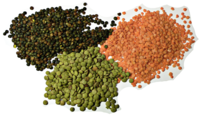
Photo from wikipedia
Lentil (Lens culinaris Medik.) is a diploid (2n = 2x = 14), self-pollinating, cool-season, grain legume that is cultivated worldwide and is highly valuable due to its high protein content.… Click to show full abstract
Lentil (Lens culinaris Medik.) is a diploid (2n = 2x = 14), self-pollinating, cool-season, grain legume that is cultivated worldwide and is highly valuable due to its high protein content. However, lentil production is constrained by many factors including biotic stresses, majority of which are fungal diseases such as ascochyta blight (AB), fusarium wilt, rust, stemphylium blight, anthracnose, and botrytis gray mold. Among various diseases, AB is a major -problem in many lentil-producing countries and can significantly reduce crop production. Breeding for AB resistance has been a priority for breeding programs across the globe and consequently, a number of resistance sources have been identified and extensively exploited. In order to increase the efficiency of combining genes from different genetic backgrounds, molecular genetic tools can be integrated with conventional breeding methods. A range of genetic linkage maps have been generated based on DNA-based markers, and quantitative trait loci (QTLs) for AB resistance have been identified. Molecular markers linked to these QTLs may potentially be used for efficient pyramiding of the AB disease resistance genes. Significant genomic resources have been established to identify and characterize resistance genes, including an integrated genetic map, expressed sequence tag libraries, gene based markers, and draft genome sequences. These resources are already being utilized for lentil crop improvement, to more effectively select for disease resistance, as a case study of the Australian breeding program will show. The combination of genomic resources, effective molecular genetic tools and high resolution phenotyping tools will improve the efficiency of selection for ascochyta blight resistance and accelerate varietal development of global lentil breeding programs.
Journal Title: Frontiers in Plant Science
Year Published: 2017
Link to full text (if available)
Share on Social Media: Sign Up to like & get
recommendations!